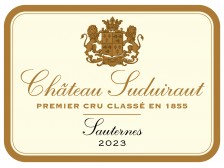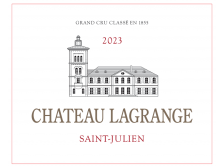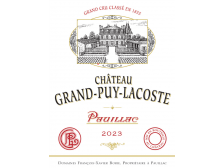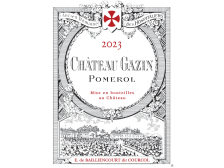2024 Futures
In the category « Long keeping », we gather all the wines of the vintage 2017 that will have, according to us, an ageing potential of at least 20 years (even if they will reach their peak before). This category is thus intended for the (very) patient ones with a great cellar, or for those who will have something to celebrate in 20 years (or more).
The ability to age well is the preserve of the finest wines, but more affordable wines can also have a great ageing potential due to their excellent vineyards, the grapes varieties used or to the winemaker’s will. The ageing varies as well depending on the temperature of the cellar (the colder the cellar is, the slower the wine will age) and the bottle’s size (wines in large containers like magnums will age slower and longer than wines in bottles).
-
In white, Domaine de Chevalier produces a model unique among its peers, made of tension, vivacity and energy. Its mineral side and its capacity to age (30 years and more) bring it closer to the greatest Burgundy whites.
More- To keep or to drink:
- Available early 2027
- Potential alcohol:
- 14%
- Organic certification:
- 2023
-
Smith Haut Lafitte's white wine has built up a solid reputation over the past 20 years, even though it is not a grand cru classé (but neither are Haut-Brion blanc and Pape-Clément blanc). A happy marriage of wood and fruit, it always delivers a beautiful aromatic complexity, from lime blossom to citrus fruit, and a lively, rich, fine structure.
More- To keep or to drink:
- Available early 2027
- Organic certification:
- 2019
-
Administered by the Rothschilds (Mouton) since 1996, Coutet has joined the leading pack of the biggest Sauternes after Yquem. Like Climens, it is a true Barsac, pure and remarkably subtle, but with a more marked liquor. Since 2005, Coutet has been in great shape! In a rare feat, the exceptional 2020 vintage came top (ahead of Yquem) in the Revue du Vin de France's ranking of Sauternes 2020 « un sommet de pureté, de précoce harmonie, de naturel ! ».
More- To keep or to drink:
- Available early 2027
- Potential alcohol:
- 13.5%
-
Doisy-Daëne may never be the sweetest wine in its sector, but its expression and aromatic refinement are unrivalled. A pure Barsac, brilliantly orchestrated by Denis Dubourdieu until 2016. The 2014 vintage was rated 94-96/100 by the Revue du Vin de France « with pure fruit and generous liquor, it is balanced by the finesse and minerality of the soil »; 96/100 for the 2016 vintage « sparkling, crystal-clear fruit, the pure character of the Barsac terroir ».
More- To keep or to drink:
- Available early 2027
-
Classified among the first growths of Sauternes during the classification of 1855, the vineyard of Rayne Vigneau (84 hectares, including 62 in one piece) is famous for its soil, which is well known to geologists, as it is composed of a great variety of precious minerals of Pyrenean origin. Without losing sight of these "luxurious" origins " Rayne Vigneau offers smooth, easily accessible wines with floral aromas that are particularly marked in their youth.
More- To keep or to drink:
- Available early 2027
-
The only 1er cru classé in the commune of Sauternes with Yquem, Guiraud offers rich, voluminous, powerful wines with a formal classicism. Certified organic since the 2011 vintage.
J-M Quarin: 96/100 "Light yellow colour with green highlights. Intense, fine, subtle, noble and complex nose. Ultra meticulous on the palate, with great class in the touch and lots and lots of taste, the wine melts on the palate all at once delicate, delicious, noble and deep. Incredibly long aftertaste." (April 2025)
More- To keep or to drink:
- Available early 2027
- Organic certification:
- 2011
-
In the commune of Preignac, Suduiraut offers a wine that reflects its geographical position: halfway between Sauternes and Barsac. The latest vintages are dazzling in terms of contained power and aromatic distinction.
According to Bettane & Desseauve (Guide 2025), “Yquem is the only wine that can still do a little better”.
More- To keep or to drink:
- Available early 2027
- Potential alcohol:
- 14%
-
Climens has been, for more than 50 years, the finest, the fruitiest and the most endearing of the Sauternes wines. Almost discreet in its first youth, Climens does not cease to develop and to refine itself in bottle. Biodynamic since the 2014 vintage. Magnificent 2016 "a fruit of an exemplary purity" noted 99/100 by the Revue du Vin de France.
Following 4 years of almost no production (none in 2017, 2018 and 2020, barely 1200 bottles in 2019), Climens changed hands in 2022.More- To keep or to drink:
- Available early 2027
- Potential alcohol:
- 13.5%
- Organic certification:
- 2016
-
Selection of the best parcels of Château de Carles (10 ha out of the 20 ha of the estate), certainly the finest and most ambitious wine of Fronsac, making since 2000 equal game with the best classified growths of the slopes of Saint-Émilion. A great wine that should be kept for at least 6 to 8 years.
More- To keep or to drink:
- Available early 2027
-
Started in 2003, the adventure of Clos Louie is a textbook case: doll's vineyard (2.3 ha) on a beautiful clay-limestone terroir of Castillon, very old vines (150 years old!) mostly Merlot and red tail malbec, careful biodynamic cultivation, double manual sorting during the harvest, little interventionist vinification, gentle maturing in 500-litre demi-muids. A true artist's wine, absent from the guides but that informed amateurs know well.
More- To keep or to drink:
- Available early 2027
- Organic certification:
- 2012
- More
- To keep or to drink:
- Available early 2027
-
Occupying the southern flank of the Haut-Brion gravelly hillside and capable of exceptional success in "small" vintages, La Mission is a powerful first growth in a more fleshy and opulent register than Haut-Brion. Proof of this is its formidable 2017 rated 96/100 by M. Galloni (Vinous) "Effortless, graceful and wonderfully nuanced, this 2017 simply has everything going for it. What a wine". As for the 2016, rated 99/100 by N. Martin (Vinous), critics compare it to the dazzling 1989, no less!
More- To keep or to drink:
- Available early 2027
- Potential alcohol:
- 14%
-
Haut-Brion is the most famous of all the Bordeaux growths, having twice been classified as 1er grand cru, in 1855 and again in 1959 (Graves classification). Haut-Brion is both the oldest of the Grands Crus, with more than five centuries (since 1509) behind it, and the most innovative, introducing stainless steel vats as early as 1960 and green harvesting as early as 1980.
Its particular situation within the Bordeaux agglomeration makes it the earliest Premier Cru on the left bank, a clear advantage in less mature vintages. For this reason, Haut-Brion's consistency is a benchmark for the whole of Bordeaux, with the intense bouquet of fresh earth, smoke and pine resin so characteristic of the appellation.
Fortunately, the unique silhouette of its bottle has disrupted the Asian market and has not triggered the same speculative interest there as it has for the other 1er grands crus classés. Haut-Brion is today without question the most qualitative and the least expensive of the premiers.More- To keep or to drink:
- Available early 2027
- Potential alcohol:
- 14.5%
-
With remarkable consistency, Potensac has been one of the most regular crus bourgeois in the northern Médoc for 30 years, proof of the know-how of the Léoville-Las Cases team (same owner). Its ability to age is always surprising, even and especially in the "early years".
More- To keep or to drink:
- Available early 2027
-
We no longer present Sociando-Mallet, which should be in a good place in the cellar of any wine lover, as the quality and above all the regularity of its last thirty vintages are so impressive. Without wishing to underestimate the hard work of the late Mr Gautreau since 1969, it must be said that the terroir, against the Gironde on a gravelly ridge comparable to that of Montrose, is indeed that of a Grand Cru Classé. Unavoidable 2016, the greatest wine of Sociando-Mallet since 1996.
More- To keep or to drink:
- Available early 2027
- Potential alcohol:
- 14%
-
In organic conversion from 2013, Durfort-Vivens was one of the very first classified growths in the Médoc to claim and display organic certification from 2016. M. Bettane is one of its most fervent defenders: "the quality/price ratio remains absolutely unique at this level of quality of terroir and work.
More- To keep or to drink:
- Available early 2027
- Organic certification:
- 2016
-
Back in top form since the early 2000s, the great Giscours estate has once again become one of the major Margaux growths, in its own distinctive style: very colourful, full-bodied and richly fruity for a Margaux. Its ageing ability has made its reputation as much as its always wise prices.
“The latest vintages are all priorities for the wine-lover,” emphasizes Bettane & Desseauve in its latest guide (2025).
More- To keep or to drink:
- Available early 2027
- Potential alcohol:
- 13.5%
-
The most serious and regular of the great classified growths of Saint-Julien, and even of the Médoc. Whatever the vintage since 1986, Lagrange never disappoints, with a constancy and an accuracy that force respect!
More- To keep or to drink:
- Available early 2027
-
Clos du Marquis is no longer the second wine of Léoville-Las Cases, but a wine in its own right produced on the parcels adjoining Léoville-Poyferré and Lagrange. In any case, his exemplary consistency for more than 30 years now commands respect.
More- To keep or to drink:
- Available early 2027
- Potential alcohol:
- 13.5%
-
Of all the second classified growths in St-Julien, Gruaud-Larose is the most vigorous and massive in young wine. But, the magic of the terroir, it acquires softness and finesse if it is given time to age. Its quality/price ratio puts it ahead of the other second classified growths of St-Julien!
More- To keep or to drink:
- Available early 2027
- Potential alcohol:
- 12.5%
- Organic certification:
- 2022
-
Intended for very long ageing in the cellar (at least 10 years even in small vintages), the wines of Léoville-Las Cases represent in each vintage one of the most perfect and purest expressions of the Médoc vineyard. As Wine Advocate has written, "Léoville-Las Cases looks more and more like Lafite rather than its close neighbour Latour".
Every vintage, Léoville-Las Cases is one of the contenders for the title of "best Bordeaux of the year", as once again with its 2020, rated 98+/100 by M. Galloni "Las Cases is one of the wines of the 2020 vintage, there is no doubt about that" and 99-100/100 by the Revue du Vin de France "a superlative wine for its depth, richness, but above all its definition".
More- To keep or to drink:
- Available early 2027
-
Grand-Puy-Lacoste is the finest of Pauillac's 5th classified growths, held with competence and care by Mr. François-Xavier Borie and his children. The latest vintages show even greater aromatic precision and tannin nobility, especially the superb 2020 vintage.
Variation Case
In music, a variation is an evolution based on a defined theme. Grand-Puy-Lacoste has thus chosen to combine 3 different formats in a single case, enabling the evolution of the wine to be followed over time. The "Caisse Variation" thus contains 1 Double-Magnum, 2 Magnums and 4 Bottles, equivalent in volume to 12 bottles.More- To keep or to drink:
- Available early 2027
-
Known for producing one of the firmest and tightest (even robust) Pauillacs available, Duhart-Milon has since 2010 refined its style to gradually approach that of Lafite (same owner and same team). New direction and progress amply confirmed, with an unprecedented charm and fatness from the 2015 vintage onwards. Given the quality of its terroir (the only 4th Grand Cru Classé in Pauillac), Duhart-Milon has certainly not finished its progression.
As the latest Bettane & Desseauve guide (2025) points out, “So many changes in recent vintages, with a great wine that has rediscovered the depth and dimension of the greatest Pauillacs”!
More- To keep or to drink:
- Available early 2027
- Organic certification:
- 2024
-
Apart from the first great classified growths, no other Bordeaux wine is as world famous as Lynch-Bages. Its worldwide success comes as much from its opulent, full-bodied and robust style, from its unfailing regularity since 1975, and from its media promotion orchestrated by Jean-Michel Cazes. Lynch-Bages was the first wine sent into space (Discovery shuttle in 1985). It is even said that it is him who gave the taste of Bordeaux to the Americans!
More- To keep or to drink:
- Available early 2027
-
Appointed cellar master in 1994, Mr. Chevallier focused on developing Lafite-Rothschild wines without losing any of the characteristic bouquet of blackcurrant, graphite and cedar. This objective was quickly achieved, placing Lafite at the top of the 1st classified growths (this was already the case in 1855), and revered as such by the Chinese market. The incredible qualities of Lafite's terroir make it a unique vintage and give Cabernet Sauvignon (more than 90% present each year) its most beautiful aromatic expressions.
The great 2020 vintage was awarded the supreme score of 100/1000 by the Revue du Vin de France: "Spectacular, bordering on perfection".
More- To keep or to drink:
- Available early 2027
- Organic certification:
- 2024
-
Previously settled on firm tannins that made them stark in their youth, Cos Labory's wines have for the last ten years changed in style, becoming more pleasant and gaining in depth and refinement (its vineyard is adjacent to those of Lafite-Rothschild and Cos d'Estournel). “Probably the best value in the 1855 classification to date”, as Bettane & Desseauve (Guide 2025) points out.
The Audoy family having sold its vineyard to the neighboring Cos d'Estournel at the beginning of 2023, a new era begins at Cos Labory.
More- To keep or to drink:
- Available early 2027
-
After 43 vintages, Mr Charmolüe sold the estate to Mr Bouygues in 2006. The change of ownership was accompanied by a spectacular project designed to bring Montrose into the 21st century: use of geothermal energy, installation of photovoltaic panels, recycling of CO2 from alcoholic fermentation...
There has also been a change of style in the wines, with a move towards greater aromatic complexity and textural refinement. Montrose nevertheless remains a wine of great breed, resting on a powerful tannic architecture and reserved for the most patient connoisseurs.More- To keep or to drink:
- Available early 2027
-
Always of a high standard for a reasonable price (in Pomerol), the wines of Gazin, medium-bodied and marked by truffles, are the archetype of the appellation and of exemplary consistency vintage after vintage. “One of Pomerol's best wines, with happy surprises after 10 years” for Bettane & Desseauve as for us.
More- To keep or to drink:
- Available early 2027
-
Vieux Château Certan is one (the last?) of the very few Bordeaux grands crus where the owners, Alexandre Thienpont and his son Guillaume since 2011, are still the only cellar masters on board. Thanks to its Cabernet Franc (30% on average), Vieux-Certan offers a firm, distinguished and refined version of Pomerol, closer to Lafleur than Petrus. Its 2022 vintage has been showered with praise, as in Vinous, where the two tasters (Galloni and Martin) each rated it 100/100.
More- To keep or to drink:
- Available early 2027
- Potential alcohol:
- 14%
-
A talented and demanding winemaker, Mr. Durantou, at the service of a great terroir flush with Pomerol's church (between Lafleur and Clinet), has revealed and propelled L'Église-Clinet among Pomerol's finest crus. L'Église-Clinet is undoubtedly one of the most subtle in terms of aromatic precision, fine grain and satiny texture. Much too soon lost in 2020, Mr. Durantou fortunately has three daughters, united and determined to continue their father's work with brio.
J-M Quarin: 96/100 "Dark red colour with black highlights. Intense. Very aromatic nose, fine, pure, fruity, smelling of black fruits, then flowers when the glass is shaken. Meticulous from the outset, particularly aromatic in the middle, with a dense body and lots of flavour, the wine evolves in a savoury, complex way towards great length, both seductive and mellow. Remarkable for the year."(April 2025)
More- To keep or to drink:
- Available early 2027































